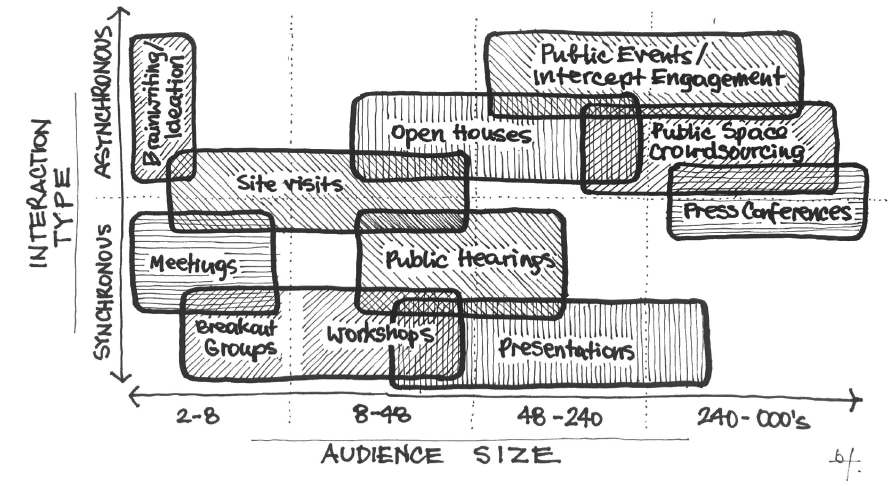Stakeholder Engagement in the Age of Social Distancing
Date
April 1, 2020“The show must go on!”
The COVID-19 pandemic has upended, in a few days, the way we live, work, and interact with each other. While both the long-term effects on how we relate to each other and the impacts on our urban environments are still to be determined, we will soon need to rethink the way we discuss the design and approval of urban building projects with stakeholders.
The approvals process, although different from locality to locality, usually involves a series of touch points with multiple stakeholders — designers, experts, city departments, city councils, public agencies, interest groups, neighbourhood associations, the public at large — which we collectively label as stakeholder or public engagement.
Now that all those events — from simple meetings to multi-day charrettes — have been canceled or moved behind closed doors, the obvious question is: How will this impact the project review process, in the assumption that we will still want to ensure stakeholder input before project approvals?
What is already clear is that neither cities, developers, nor the public can afford to ‘put on ice’ all projects in the pipeline for months, just because it is not safe to engage in person as part of the process. The obvious, and simple, answer to this question is to use technology. We agree, in general, but there are things to consider as you dig deeper.
So far, we have typically utilized online outreach tools to complement physical activities, but never to substitute them. With COVID-19, digital engagement is no longer a nice-to-have, but becomes the essential element of the engagement process. The question now is not “should we do it?” but rather “how do we do it?”
To approach this challenge in a practical and constructive way, we need to first understand the in-person activities that we currently use throughout a project’s approval process. This understanding is important, as not all activities and events are created equal in terms of methods, dynamics, communication patterns, participation forms, participant quantities, etc.
For the same reason, the technology best suited for the virtual version of the supplanted physical activities will necessarily vary from case to case — and in some cases will need to be adapted to these new needs.

Figure 1. The proposed stakeholder engagement typology organized by interaction type and audience size. Each of the engagement types will need a tailored technology solution to successfully transfer online. Click here to view larger image.
A straightforward and useful way to organize the forms of engagement activities is along two base criteria: (1) The interaction type between the participants, and (2) the audience size participating in the activity. While there may be other ways to ‘slice and dice’ engagement activities, these two are critical because they are directly related to the types of technology that could be applicable for each case.
Interaction type focuses on the temporal alignment of the interventions by the participants in an engagement activity: Do they engage with each other at the same time, i.e. synchronously (such as in a workshop), or do they engage individually at their own pace, independently of whether they are in the same place with other people, i.e. asynchronously (such as during an open house)? This is important because it tells you what the technology chosen as a replacement needs to be able to do.
Audience size is straightforward: You cannot engage the same way with a large group as you would do with a small group. There are clear thresholds where the dynamic changes; up to eight people is manageable for unstructured two-way conversations, up to 48 can have two-way conversations if there are rules to make it work, up to 240 is viable for events with structured (or semi-decentralized) communications, and more than 240 requires one-to-many ‘broadcasting’ events (or another form of decentralized, unlinked participation). All this is important because it tells you how many participants the technology needs to support.
We have identified ten types of stakeholder engagement activities or events that can be described through the lens of a two-dimensional interaction type vs. audience size matrix. Figure 1 above illustrates where each of the ten activities sits within this matrix.
Each one of the ten activities is a candidate to be ‘translated’ into a virtual format. There are certain existing technological applications that work best for each environment. For some of these, a mix of technology solutions may apply, given that there may not be an existing single application that does exactly what is required.
Asynchronous events are generally easier to transfer online, because they need not provide the protocols for people to interact with each other in real time. A survey can be responded to in person or online in almost the same way, while a design charrette is difficult to translate online without losing its intrinsic dynamics.
Therefore, in some instances, what is currently one synchronous physical activity may need to be subdivided into a series of asynchronous virtual activities to accomplish the process’ needs. For example, a design workshop may need to be split up into ideation, discussion, and selection phases to allow for input to come in and be distributed with the wider, virtual group.
Key criteria for choosing the most applicable technology (especially if the end user is the public at large) are the levels of usefulness, convenience, personalization, choice, experience, and involvement for the user. Applications should be as straightforward, intuitive, simple, accessible, ubiquitous, barrier-free and device- and operating system-agnostic as possible to maximize participation and reduce user frustration.
Of course, there are still equipment, equity and accessibility issues that will need to be figured out. Yet most people already own or have access to a smartphone or a computer. And in the current situation, likely they have someone at home that has a device to communicate. Existing engagement and communications software producers have already advanced towards making their platforms accessible to people with different abilities. In short, the world is moving in the right direction.
So far, we have only talked about mimicking the physical activities online. This is, however, an incredible opportunity to reinvent some of these activities from scratch. Think, for example, about the inefficiencies, inequities and anachronisms that are currently built into the review process or the public hearing process. This is a chance to reimagine, from the ground up, how the review process and its related activities should actually work.
In summary: Our world is changing fast — and physical engagement, for all the benefits it provides, is cut out of the equation for the foreseeable future. Technology, if well utilized and attuned to the specific engagement need, can be leveraged immediately to do most of what we do now in a face-to-face setting. The apps are already out there; it’s up to us to leverage them the best we can.
This current challenge is not just about moving from physical to virtual and then returning “back to normal” once the pandemic subsides. This is an incredible opportunity to reshape engagement so it is broader, deeper, and more meaningful for all. And should we dare to say more fun too?
YouTube first started as a site mirroring what we already did before (upload cat videos), but then creative people leveraged the capabilities of the platform to do something new altogether (vlogging). Similarly, we should use this moment to rewrite the engagement playbook and create a “new normal.” Oh, the places we can go!
Read Oliver’s extended whitepaper.
Stakeholder Engagement InfographicOliver Hartleben is a city planner with a public administration degree from the Harvard Kennedy School focused on existing and evolving public outreach, demographic, mobility, built form, and innovation topics.
A lateral thinker by nature, Oliver brings together his experience in engaging public, private and community stakeholders for the identification of new opportunities and synergies. Oliver is NCI System-certified to facilitate design charrettes, has experience in conducting online engagement processes, and leads IBI Group’s R&D Unit, TH!NK.
Oliver Hartleben is a city planner with a public administration degree from the Harvard Kennedy School focused on existing and evolving public outreach, demographic, mobility, built form, and innovation topics. A lateral thinker by nature, Oliver brings together his experience in engaging public, private and community stakeholders for the identification of new opportunities and synergies. Oliver is NCI System-certified to facilitate design charettes, has experience in conducting online engagement processes, and leads IBI Group’s R&D Unit, TH!NK.









